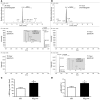Prolylcarboxypeptidase regulates food intake by inactivating alpha-MSH in rodents
- PMID: 19620781
- PMCID: PMC2719925
- DOI: 10.1172/JCI37209
Prolylcarboxypeptidase regulates food intake by inactivating alpha-MSH in rodents
Abstract
The anorexigenic neuromodulator alpha-melanocyte-stimulating hormone (alpha-MSH; referred to here as alpha-MSH1-13) undergoes extensive posttranslational processing, and its in vivo activity is short lived due to rapid inactivation. The enzymatic control of alpha-MSH1-13 maturation and inactivation is incompletely understood. Here we have provided insight into alpha-MSH1-13 inactivation through the generation and analysis of a subcongenic mouse strain with reduced body fat compared with controls. Using positional cloning, we identified a maximum of 6 coding genes, including that encoding prolylcarboxypeptidase (PRCP), in the donor region. Real-time PCR revealed a marked genotype effect on Prcp mRNA expression in brain tissue. Biochemical studies using recombinant PRCP demonstrated that PRCP removes the C-terminal amino acid of alpha-MSH1-13, producing alpha-MSH1-12, which is not neuroactive. We found that Prcp was expressed in the hypothalamus in neuronal populations that send efferents to areas where alpha-MSH1-13 is released from axon terminals. The inhibition of PRCP activity by small molecule protease inhibitors administered peripherally or centrally decreased food intake in both wild-type and obese mice. Furthermore, Prcp-null mice had elevated levels of alpha-MSH1-13 in the hypothalamus and were leaner and shorter than the wild-type controls on a regular chow diet; they were also resistant to high-fat diet-induced obesity. Our results suggest that PRCP is an important component of melanocortin signaling and weight maintenance via control of active alpha-MSH1-13 levels.
Figures







Comment in
-
Reduced levels of neurotransmitter-degrading enzyme PRCP promote a lean phenotype. [corrected].J Clin Invest. 2009 Aug;119(8):2130-3. doi: 10.1172/JCI40001. Epub 2009 Jul 20. J Clin Invest. 2009. PMID: 19620779 Free PMC article.
Similar articles
-
Reduced levels of neurotransmitter-degrading enzyme PRCP promote a lean phenotype. [corrected].J Clin Invest. 2009 Aug;119(8):2130-3. doi: 10.1172/JCI40001. Epub 2009 Jul 20. J Clin Invest. 2009. PMID: 19620779 Free PMC article.
-
New aspects of melanocortin signaling: a role for PRCP in α-MSH degradation.Front Neuroendocrinol. 2011 Jan;32(1):70-83. doi: 10.1016/j.yfrne.2010.09.001. Epub 2010 Oct 25. Front Neuroendocrinol. 2011. PMID: 20932857 Free PMC article. Review.
-
Prolyl carboxypeptidase in Agouti-related Peptide neurons modulates food intake and body weight.Mol Metab. 2018 Apr;10:28-38. doi: 10.1016/j.molmet.2018.02.003. Epub 2018 Feb 8. Mol Metab. 2018. PMID: 29459251 Free PMC article.
-
Deletion of prolyl carboxypeptidase attenuates the metabolic effects of diet-induced obesity.Am J Physiol Endocrinol Metab. 2012 Jun 15;302(12):E1502-10. doi: 10.1152/ajpendo.00544.2011. Epub 2012 Mar 27. Am J Physiol Endocrinol Metab. 2012. PMID: 22454290 Free PMC article.
-
Prolylcarboxypeptidase (PrCP) inhibitors and the therapeutic uses thereof: a patent review.Expert Opin Ther Pat. 2017 Oct;27(10):1077-1088. doi: 10.1080/13543776.2017.1349104. Epub 2017 Jul 12. Expert Opin Ther Pat. 2017. PMID: 28699813 Review.
Cited by
-
A Cross-sectional Study of KLKB1 and PRCP Polymorphisms in Patient Samples with Cardiovascular Disease.Front Med (Lausanne). 2016 Apr 29;3:17. doi: 10.3389/fmed.2016.00017. eCollection 2016. Front Med (Lausanne). 2016. PMID: 27200353 Free PMC article.
-
Physiologic activities of the contact activation system.Thromb Res. 2014 May;133 Suppl 1(0 1):S41-4. doi: 10.1016/j.thromres.2014.03.018. Thromb Res. 2014. PMID: 24759141 Free PMC article.
-
POMC: The Physiological Power of Hormone Processing.Physiol Rev. 2018 Oct 1;98(4):2381-2430. doi: 10.1152/physrev.00024.2017. Physiol Rev. 2018. PMID: 30156493 Free PMC article. Review.
-
Decrease of Prolylcarboxypeptidase Dose of Aqueous Humor is Involved in the Pathogenesis of Primary Open-Angle Glaucoma via Finetuning of the Local Ocular Renin-Angiotensin System.Dose Response. 2024 Oct 29;22(4):15593258241298062. doi: 10.1177/15593258241298062. eCollection 2024 Oct-Dec. Dose Response. 2024. PMID: 39484664 Free PMC article.
-
Prolylcarboxypeptidase promotes IGF1R/HER3 signaling and is a potential target to improve endocrine therapy response in estrogen receptor positive breast cancer.Cancer Biol Ther. 2022 Dec 31;23(1):1-10. doi: 10.1080/15384047.2022.2142008. Cancer Biol Ther. 2022. PMID: 36332175 Free PMC article.
References
-
- Stylianou I.M., et al. Microarray gene expression analysis of the Fob3b obesity QTL identifies positional candidate gene Sqle and perturbed cholesterol and glycolysis pathways. Physiol. Genomics. 2005;20:224–232. - PubMed
-
- Williams D.L., Schwartz M.W. The melanocortin system as a central integrator of direct and indirect controls of food intake. Am. J. Physiol. Regul. Integr. Comp. Physiol. 2005;289:R2–R3. - PubMed
Publication types
MeSH terms
Substances
Grants and funding
- R01 DK080003/DK/NIDDK NIH HHS/United States
- DK70039/DK/NIDDK NIH HHS/United States
- DK52581/DK/NIDDK NIH HHS/United States
- R01 HL052779/HL/NHLBI NIH HHS/United States
- HL65194/HL/NHLBI NIH HHS/United States
- P01 HL057346/HL/NHLBI NIH HHS/United States
- DK080003/DK/NIDDK NIH HHS/United States
- P20RR021929/RR/NCRR NIH HHS/United States
- R01 DK084065/DK/NIDDK NIH HHS/United States
- P20 RR021929/RR/NCRR NIH HHS/United States
- R01 DK070039/DK/NIDDK NIH HHS/United States
- R01 HL065194/HL/NHLBI NIH HHS/United States
- R01 DK052581/DK/NIDDK NIH HHS/United States
- HL52779/HL/NHLBI NIH HHS/United States
- HL57346/HL/NHLBI NIH HHS/United States
LinkOut - more resources
Full Text Sources
Other Literature Sources
Molecular Biology Databases

